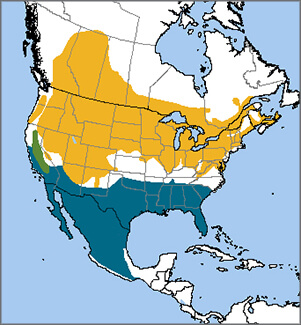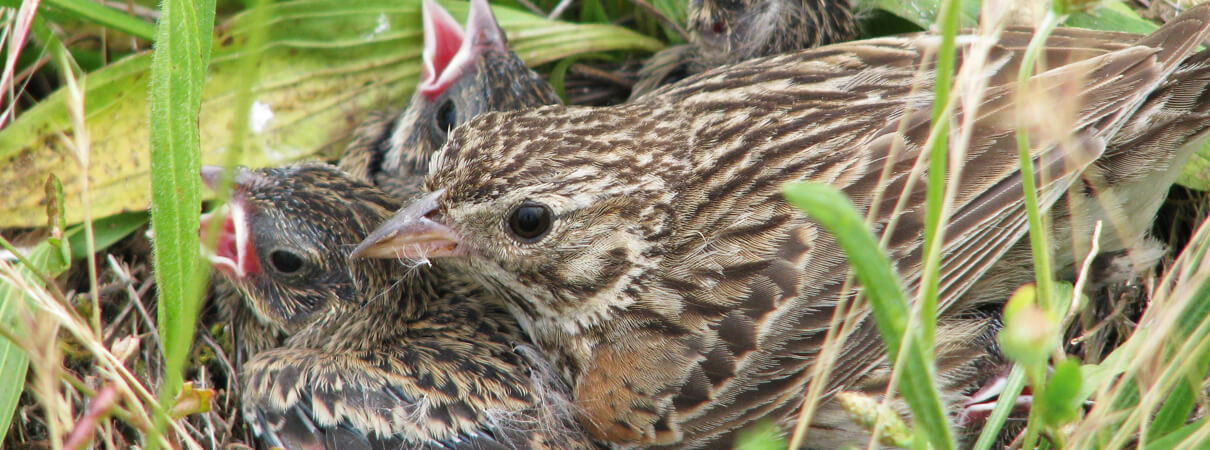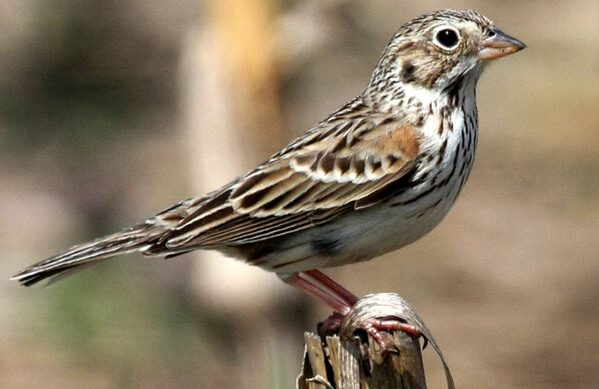
The Vesper Sparrow's sweet song, a combination of clear whistles and trills, can often be heard at twilight — roughly the same time as Catholic vespers services, which earned the bird its name. Some would call this species a "little brown job” at a glance, but with a keen eye, it's not difficult to note a few distinguishing features: white outer tail feathers, a white eye-ring, and a chestnut shoulder patch.
Vesper Sparrows are fairly adaptable; for example, they may nest on reclaimed mine sites or in newly burned areas. But their overall population is declining due to habitat loss on both breeding and wintering grounds. Modern farming practices, including pesticide use, hedgerow clearing, and early hay harvesting, have also been detrimental to this species.
ABC's Bob Altman is an expert on the Oregon Vesper Sparrow, a Western subspecies with a very limited range. He's working to ensure that the population of this bird, now numbering only about 2,000, remains intact in spite of the rapidly growing human population in the Pacific Northwest.
Evolution of a Name
This species was once known as the "Bay-winged Bunting" or "Grass Finch." The name "Vesper Sparrow" was first used in an 1858 essay in The Atlantic Monthly by naturalist Wilson Flagg, who had met people who called the sparrow “the Vesper-bird … from its evening hymn, or vespers.” Flagg's fondness for this name caught the attention of John Burroughs, who would become one of America's most famous nature writers.
Writing in the same magazine a few years later, Burroughs repeated Flagg's observations, popularizing the name ever further. By the time the American Ornithologists' Union (AOU) published its first checklist in 1866, the new name, Vesper Sparrow, had stuck.
Bird of Mexican BirdScapes
A breeding bird of grasslands and fields across much of the north-central United States and Canada, most Vesper Sparrows migrate to the southern and central United States and Mexico for the winter. (Vesper Sparrows are present all year in a few areas, most notably in California's Central Valley.) Many winter in the Chihuahuan Desert grasslands of Mexico, which is also an important habitat for other North American migrants including Long-billed Curlew, Sprague's Pipit, and Chestnut-collared Longspur, as well as resident species that occur nowhere else such as Worthen's Sparrow.
With our partner Pronatura Noreste and guided by our BirdScapes approach to migratory bird conservation, we're working successfully to promote bird-friendly grazing practices in the Chihuahuan Desert region for the benefit of all of these birds.
Sign up for ABC's eNews to learn how you can help protect birds
Farmer's Friend
Vesper Sparrows are relatively solitary and inconspicuous, preferring to walk or run rather than fly. They sometimes gather in small flocks on their wintering grounds or during migration.
Foraging in weedy fields, brushy edges, and recently mowed fields, Vesper Sparrows scratch for seeds and insects with strong legs and feet. This is a beneficial species in agricultural areas, as the birds eat many crop-destroying insects and weed seeds.

Vesper Sparrow and chicks by Suzanne Beauchesne
Like other grassland birds such as Baird's Sparrow, Grasshopper Sparrow, and Horned Lark, Vesper Sparrows nest on the ground. Their nest is an open cup, placed in a depression often dug by the female. Nests are usually well-camouflaged under clumps of grass. When a potential predator approaches too closely, female Vesper Sparrows will perform a "broken-wing" distraction to divert the intruder's attention.
Stopping Steep Declines
Vesper Sparrow populations declined by 37 percent between 1966 and 2014, according to the North American Breeding Bird Survey. The Oregon Vesper Sparrow, one of four subspecies, is in particular trouble.
Under Bob Altman's leadership, ABC recently submitted a petition for federal protection of this subspecies under the Endangered Species Act. “With so few birds remaining, many in small and isolated populations, the Oregon Vesper Sparrow needs the immediate protection and conservation focus made possible through ESA listing,” says Altman. “Every year, more populations are being lost, and we are not seeing the establishment of new populations where habitat restoration has occurred.”
Meanwhile, Altman reports that habitat restoration for the sparrow is taking place, with organizations like the Greenbelt Land Trust supporting conversion of degraded habitat into healthy landscapes that draw in Vesper Sparrows and other rare and declining species. Efforts like these, Altman says, “provide hope that in the years to come, the Oregon Vesper Sparrow will once again be a prominent songster on the grasslands and savannahs of the Pacific Northwest.”
Donate to support ABC's conservation mission!



















































